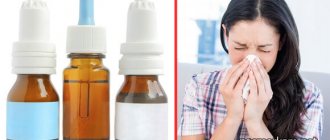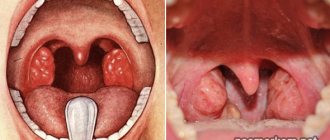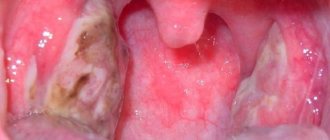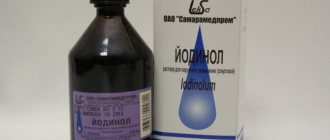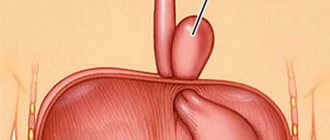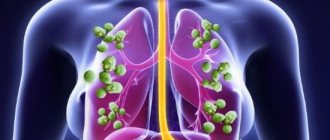Why is mucosal restoration necessary?
Before you find out what is needed to restore the mucous membrane, it is worth understanding why it is needed. The mucous membrane of the throat and nasal passages serves as a reliable barrier against the penetration of various infections, bacteria and viruses into the body. It helps get rid of the accumulation of pathogenic microorganisms and dust in the inhaled air. Another function of the mucous membrane is to warm the incoming air.
Therefore, if the mucous membranes are damaged, every effort must be made to restore them. Otherwise, the oral cavity and nose will become a gateway for many microbes living in the environment. Violation of the integrity of the mucous membrane leads to the formation of chronic foci of infection.
If the mucous membranes are damaged and thinned, symptoms such as discomfort when swallowing and sore throat will occur. But only an otolaryngologist can make an accurate diagnosis. Upon examination, the doctor will detect erosion and inflammation on the surface of the upper respiratory tract.
Normal microflora and its composition
Research in this area is carried out by microbiology. The entire set of populations of microorganisms living on the surface of the mucosa is called microbiocenosis. Optimal indicators of the oral cavity - humidity, temperature, alkaline environment; the presence of folds and various depressions makes it possible for a wide variety of bacteria to live.
They are divided into gram-negative and gram-positive, aerobic and anaerobic, beneficial and harmful to the body. Mostly the microflora of the oral cavity of a healthy person consists of several dozen “inhabitants”. But if their number does not exceed the norm, and there are no favorable conditions for active reproduction, then they remain harmless and do not harm our body.
When analyzing and carefully studying these microorganisms, scientists identify:
- autochthonous (resident) substances - which are natural components of the surface of the mucous membrane of any person;
- allochthonous (indigenous) – entering the oral cavity through internal movements, for example, from the nasal sinuses, gastrointestinal tract, etc.;
- transient - mainly considered pathogenic, since they should not normally be present in the mouth, but are brought there from the environment, for example, with dirty hands or other objects.
Resident bacteria are considered the most important, that is, those that must be present in the microflora of the human oral cavity. They can also be divided into:
- obligate, that is, constant and unchanging, without which the natural processes of digestion, etc., are impossible;
- facultative - pathogenic microorganisms predominate here, which, if the correct balance is disturbed, lead to the occurrence of various pathologies.
The resistant composition includes about 30 species of microorganisms. Among them there are bacteria, viruses, fungi, protozoa, etc. The most popular are certain groups of cocci, which make up about a third of the total microflora, and some other elements:
- Streptococci - take part in the processing of carbohydrates when eating food, and also form organic acids. They suppress the spread of pathogenic microorganisms in the oral cavity. Most of them are on the enamel of the teeth and tongue. But if the microflora is disturbed and there are too many of these bacteria, this can lead to increased acidity and rapid destruction of hard tissues.
- Staphylococci are also quite common and are found in most people in a healthy state. Take part in the digestive process. But with a sharp increase in their number in the oral cavity, they can lead to caries, inflammatory or purulent formations. It is these microorganisms that predominantly make up dental plaque.
- Veillonella - continue the work of previous bacteria and convert organic acids to water molecules and carbon dioxide. Thanks to these elements, it is possible to avoid the occurrence of caries. But under certain conditions and a violation of the optimal composition, they cause bacterial infections and increase acidity, which contributes to the destruction of enamel.
- Neisseria are also involved in the processing of carbohydrates and, when their quantity increases, can become pathogenic.
- Lactobacilli - during their life processes they produce lactic acid. This simultaneously gives two effects - strengthens hard tissues and stops the active reproduction of pathogenic microorganisms.
- Actinomycetes (fungi) – determine the composition of the microflora of the oral cavity and intestines. In a normal state, they are able to break down carbohydrates and participate in the digestion process. But if the balance is disturbed, then they cause inflammation of the gums, actively spread along the destroyed areas of the tooth roots and provoke the formation of granulomas.
It is also worth noting spirochetes, which often lead to the appearance of sore throat and ulcerative stomatitis. All these microorganisms in most cases are present even in the microflora of a healthy person. More often they are deposited on the surface of the teeth in the form of plaque, forming plaques. But if optimal indicators are violated, they can lead to serious illnesses.
General recommendations during the recovery period
General recommendations that will answer the question of how to restore the throat after pharyngitis are as follows:
- It is necessary to monitor the level of humidity and purity of the inhaled air. To do this, ventilate the room more often, perform daily wet cleaning, and plant indoor plants. You can also install special air humidifiers.
- The patient needs to reconsider his lifestyle, give up bad habits such as smoking and drinking alcohol.
- During the recovery period you need to follow a diet. The products are subject to minimal heat treatment. The diet is made up of the maximum amount of fresh, plant components. It is necessary to enrich your diet with vitamins and minerals. Also, during the entire period of treatment and rehabilitation, you should drink large amounts of warm liquid.
- If pharyngitis was caused by harmful working conditions, then you should transfer to another job.
- It is necessary to stimulate the immune system. This will help prevent relapse of the disease and allow you to quickly cope with the problem.
By eliminating the aggressive effects of adverse external factors and normalizing your lifestyle, you can achieve significant results in the treatment of mucous membranes.
It is equally important to identify and treat concomitant diseases. An endocrinologist, gastroenterologist and dentist will help eliminate the provoking factors for the development of pharyngitis. It is worth visiting these specialists and undergoing the necessary examinations. An integrated approach will help eliminate the problem and prevent complications.
Who is guilty?
Dysbacteriosis is not a diagnosis, but a symptom; it does not arise out of nowhere, but is always a consequence of problems in other systems of the body. Therefore, simply restoring beneficial microflora is pointless until the cause that upsets this balance is found. There may be a lot of people to blame for the death of beneficial bacteria and the massive colonization of pathogenic ones.
The most common causes of dysbiosis:
- dry food;
- monotonous nutrition, and it doesn’t matter what a person leans on: healthy vegetables or unhealthy sweets;
- strict diets and especially fasting;
- travel, in which the usual type of food inevitably changes;
- antibiotic treatment;
- long-term stress.
Having eliminated the root cause, it is necessary to move on to active action: suppress excess bacterial contamination in the small intestine and restore beneficial microflora in the large intestine.
Article on the topic
Meat or apple? Nutrition rules for dysbiosis
Medications
Medications are the most effective. The active ingredients in the drugs stop the development of infection and kill microbes - the main cause of inflammation of the mucous membrane. The drugs are used both for the treatment of pharyngitis and for subsequent recovery.
The following groups of medications are usually prescribed:
- Antibacterial – Chlorophyllipt and Bioparox.
- Homeopathic – Tonsilgon, Faringomed, Traumeel C.
- Antifungals such as Candida.
- Secretolytics, for example, ACC and Fluditec.
- Regenerative, such as Solcoseryl and Karotolin.
- Antiseptic - Miramistin, Givalex, Rotokan, Iodinol, Lugol's solution, furacillin.
- Moisturizing, for example, Aquamaris, No-salt.
- Immunomodulatory and immunocorrectors - Bronchomunal, Lyzobact, Hexaliz and Polyoxidonium.
Most often these are products for topical use in the form of sprays, inhalation solutions and gargling. Thanks to local action, the maximum therapeutic effect is achieved at the site of application. The drugs do not have an effect on the entire body.
To recover from pharyngitis, the following medications are used:
- Imudon is available in the form of lozenges. The drug has an immunomodulatory effect and normalizes the microflora of the larynx. The product can be used by children from the age of five. Take 1 tablet every hour.
- Yox in the form of a spray and rinse solution has a healing effect due to the allantoin it contains. It eliminates minor damage to the mucous membrane. It can be used by adults and children starting from 5 years old.
- Lyzobact in the form of lozenges contains lysozyme and pyridoxine. It helps eliminate erosion and inflammation. The drug is approved for use by children and adults. Take it every 2 hours.
Inhalations will help eliminate dry mucous membranes. For the procedure, it is best to use a nebulizer, which allows you to spray the medicine. This method of treatment is the most effective. An effective remedy is a composition of ordinary table salt dissolved in alkaline mineral water.
If you need to restore the throat mucosa with chronic pharyngitis, you cannot do without medications. A chronic process means that there are still microbes in the body that cause inflammation. Only chemicals can destroy them.
Factors that provoke deterioration
In a healthy state, all microorganisms create a certain balance in the ecosystem. And under the influence of internal or external reasons, this balance is disrupted. In this case, doctors and scientists talk about dysbiosis. Depending on the characteristics of its course, different symptoms are distinguished:
- plaque appears on the tongue and other surfaces;
- inflammatory processes occur in the hard and soft tissues of the oral cavity;
- people around feel an unpleasant odor;
- Herpes or another infection may begin;
- ulcers often form on the mucous membrane;
- Cracks in the corners of the mouth or on the lips are also typical.
This kind of condition doesn’t just happen. It is usually preceded by other problems:
- lack of vitamins, irregular nutrition;
- decreased immunity;
- chronic diseases of the oral cavity, mainly dental;
- disturbances in the gastrointestinal tract;
- unfavorable environment, exposure to harmful substances;
- pathologies of the salivary glands;
- structural anomalies of the maxillofacial apparatus;
- bad habits;
- long-term use of medications, for example, antibiotics, uncontrolled self-medication;
- excessive enthusiasm for various antiseptic rinses.
And if in a normal state any microorganisms found in the oral cavity perform their functions, then when the balance of the ecosystem is disturbed, individual colonies of fungi, viruses or bacteria increase sharply. In this case, their beneficial effects often become pathogenic and cause certain diseases of the oral cavity, and then of other body systems.
Dysbacteriosis of the mucous membrane goes through three stages:
- Compensated, when the main symptoms practically do not appear. This condition is discovered accidentally during specific tests.
- Subcompensated – there is an unpleasant odor, the gums burn, itch, and redness or swelling of the mucous membrane occurs, which can be noticed during a dental examination.
- Decompensated - leads to serious diseases of the oral cavity, caries appears, gums bleed, herpes or other infectious pathologies may occur.
Traditional medicine
For those who prefer natural remedies, herbs and herbal preparations will come to the rescue. Some of them are no less effective than medications. For example, the following medicinal solutions will help eliminate swelling and remove erosions on the mucous membrane:
- diluted sea buckthorn oil;
- rose hip;
- eucalyptus extract;
- propolis tincture.
Their regular use will promote rapid healing of damage and tissue regeneration.
Infusions of chamomile and sage are used. They are brewed and used for rinsing. Sea salt will also work. Dilute a tablespoon in warm water and gargle with the solution. Salt removes excess fluid from tissues, which eliminates swelling.
Inflammation of the pharyngeal mucosa not only causes discomfort, but also increases the risk of developing other diseases, so at the slightest suspicion that the disease has returned, you should definitely consult a specialist. You should not self-medicate. Incorrectly chosen tactics and means can lead to the disease becoming chronic. Then it will be much more difficult to fight him.
Principles of treatment
How to restore the throat mucosa and cure irritation? Drug therapy for ENT diseases involves the use of drugs with antiseptic, antiviral and antibacterial effects. It is advisable to include local drugs in the complex treatment regimen - this will prevent excessive stress on the detoxification organs (kidneys, liver).
To stop catarrhal processes, use:
- moisturizing inhalations;
- rinsing with antiseptics;
- irrigating the throat with sprays.
You can improve tissue trophism with the help of enzyme medications (“Papain”, “Lysozyme”), which not only destroy pathogens, but also restore the normal pH level in the mucosa.
Immunostimulating agents and mineral-vitamin complexes will help increase the body's resistance, and thereby prevent the recurrence of infectious diseases. Deficiency of vitamins and microelements is one of the key reasons for the decrease in general and local immunity.
How to speed up the restoration of tissue integrity in the throat mucosa? The presence of hyperthermia and swelling always indicates acute inflammation of the ciliated epithelium. Non-steroidal anti-inflammatory drugs (NSAIDs) can relieve pathological processes and discomfort. Most of them not only prevent the synthesis of inflammatory mediators, but also inhibit the activity of pain receptors, which helps eliminate pain.
With sharing
Antibiotics may be prescribed to suppress excess growth of pathogenic microflora. But, since they also suppress the growth of beneficial bacteria, the prescription can only be made by a doctor after a microbiological examination of stool.
When the “internal enemy” is destroyed, the intestines can be populated with beneficial microflora. For this purpose, various bacterial preparations are used. They contain live cultures that have an inhibitory effect on pathogenic microbes. Up to 10% of beneficial microbes from the drug are fixed in the intestines and begin to perform the function of normal microbial flora, stimulating the formation of local immunity. This creates a kind of nutrient medium for the development of beneficial bacteria.
Most likely, you will have to adjust your diet. If dysbiosis is accompanied by constipation, you should give up baking and add more fiber and liquid to the menu. In case of intestinal disorders, on the contrary, you need to minimize raw vegetables and fruits and give preference to products with enveloping properties.
